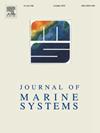Comparing in situ and satellite-derived primary production estimates in the Canary Current upwelling region
IF 2.7
3区 地球科学
Q2 GEOSCIENCES, MULTIDISCIPLINARY
引用次数: 0
Abstract
Satellite-based Net Primary Production (NPP) estimates are arguably the best way to improve our understanding of large-scale ocean productivity and to validate Earth System Models. Despite significant progress over recent decades, satellite-derived NPP estimates still suffer from large uncertainties, primarily due to the limited number of in situ primary production (PP) measurements available for their validation. In addition, the most widely used algorithms lead to different, sometimes even contradictory, results. Along with measurements of chlorophyll a concentration (Chla) and phytoplankton biomass (Cphyto), here we present in situ measurements of PP using 14C uptake and 13C isotope tracing, as well as O2 and 18O2 evolution inside incubation bottles, across the transition zone from the coastal Canary Eastern Boundary Upwelling System (CanEBUS) to the open ocean waters of the Cape Verde Frontal Zone (17–23°N; 16–26°W). We also calculate assimilation numbers ( and growth rates (μ) from in situ measurements. First, we compared in situ PP estimates measured concurrently using the four abovementioned techniques. We then tested the performance of four widely-used models including the Vertically Generalized Production Model (VGPM) and its variant based on Eppley's description of the growth function (Eppley), the Carbon-based Productivity Model (CbPM), and the Carbon, Absorption and Fluorescence Euphotic-resolving model (CAFE), along with the satellite-derived input variables that feed these algorithms. We found that the Chla-based VGPM and Eppley models were significantly correlated with in situ estimates, regardless of the satellite source used as input data. As for models based on Cphyto, only the CbPM from the Visible Infrared Imaging Radiometer Suite (VIIRS) data demonstrated performance comparable to that of the Chla-based models. In all other cases, Cphyto-based models were uncorrelated with in situ PP estimates. Our results indicate that the bias associated with the VGPM and Eppley models is primarily due to the algorithms' inability to accurately assess . Meanwhile, the retrieval of both satellite-derived Cphyto and μ leads to a poor estimate of NPP by the CbPM. Our findings suggest that enhancing the accuracy of NPP estimates derived from satellite-based models necessitates the refinement of the methodology employed in deriving the input data and their subsequent validation, rather than developing increasingly complex models.
比较加那利海流上升流区域的原位和卫星初步产量估算
基于卫星的净初级生产力(NPP)估计可以说是提高我们对大规模海洋生产力的理解和验证地球系统模型的最佳方法。尽管近几十年来取得了重大进展,但卫星衍生的NPP估算仍然存在很大的不确定性,这主要是由于可用于验证的原位初级生产(PP)测量数量有限。此外,最广泛使用的算法会导致不同的,有时甚至是矛盾的结果。除了叶绿素a浓度(Chla)和浮游植物生物量(Cphyto)的测量外,本文还介绍了利用14C吸收和13C同位素示踪对PP进行的原位测量,以及培养瓶内O2和18O2的演变,这些测量横跨从沿海加那利东部边界上升流系统(CanEBUS)到佛德角锋面区(17-23°N;第16 - 26页°W)。我们还计算了同化数(Poptb)和生长率(μ)。首先,我们比较了使用上述四种技术同时测量的原位PP估计值。然后,我们测试了四种广泛使用的模型的性能,包括垂直广义生产模型(VGPM)及其基于Eppley生长函数描述的变体(Eppley)、碳基生产率模型(CbPM)、碳、吸收和荧光真实分辨模型(CAFE),以及为这些算法提供数据的卫星衍生输入变量。我们发现基于chla的VGPM和Eppley模型与原位估计值显著相关,而不考虑使用卫星源作为输入数据。对于基于Cphyto的模型,只有来自可见光红外成像辐射计套件(VIIRS)数据的CbPM表现出与基于chla的模型相当的性能。在所有其他情况下,基于植物的模型与原位PP估计值不相关。我们的研究结果表明,与VGPM和Eppley模型相关的偏差主要是由于算法无法准确评估Pbopt。同时,卫星衍生的叶绿素和μ的反演导致CbPM对NPP的估计较差。我们的研究结果表明,提高基于卫星模型的NPP估计的准确性需要改进用于导出输入数据及其后续验证的方法,而不是开发越来越复杂的模型。
本文章由计算机程序翻译,如有差异,请以英文原文为准。
求助全文
约1分钟内获得全文
求助全文
来源期刊

Journal of Marine Systems
地学-地球科学综合
CiteScore
6.20
自引率
3.60%
发文量
81
审稿时长
6 months
期刊介绍:
The Journal of Marine Systems provides a medium for interdisciplinary exchange between physical, chemical and biological oceanographers and marine geologists. The journal welcomes original research papers and review articles. Preference will be given to interdisciplinary approaches to marine systems.
 求助内容:
求助内容: 应助结果提醒方式:
应助结果提醒方式:


